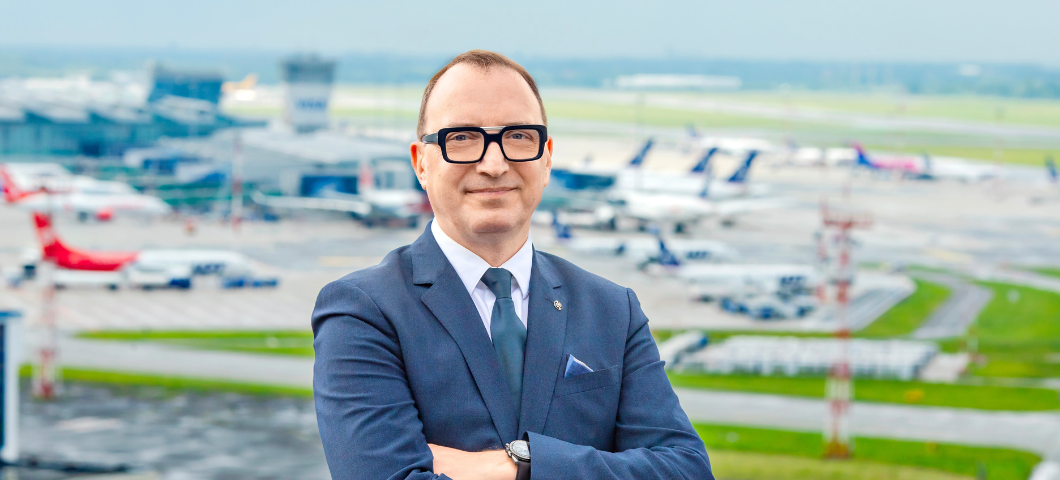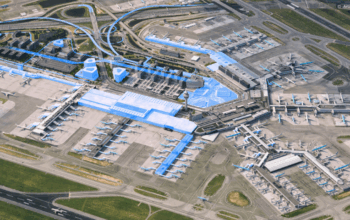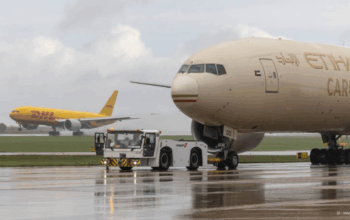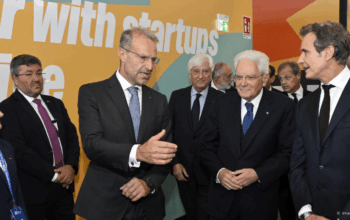
An Interview with Adam Sanocki, Chief Strategy and Marketing Officer at Polish Airports (PPL)
An exclusive ACI EUROPE interview with Adam Sanocki, Chief Strategy and Marketing Officer (CSMO) at Polish Airports.
There is no doubt that passenger traffic is flourishing in Poland right now – in the first half of 2025, passenger volumes increased by +14.9% compared to the same period last year. What factors have contributed to this success, and how will you encourage this impressive growth to continue in the future?
This is not a temporary rebound but a sustained trend. In the first half of 2025, Polish airports grew more than three times faster than the EU average, and in August Poland led the EU+ in traffic growth. The upswing is driven by rising incomes and very strong outbound tourism, alongside a maturing inbound market for city breaks and VFR. There’s also a network effect: LOT’s expansion on medium- and long-haul routes and new services to the Middle East and Africa are strengthening Warsaw’s hub role and diversifying traffic flows. On PPL’s side, operational and commercial readiness was decisive – from airline incentive packages and process automation to precise, co-marketed promotion with carriers and destinations. To sustain momentum, we’re focused on quality – adding more long-haul routes and a dense regional mesh across Central & Eastern Europe – and on processing speed thanks to new CT scanners and better turnaround management. In parallel, we’re building a capacity “bridge” in Warsaw that will carry us safely to the opening of Centralny Port Komunikacyjny.
Your new collaboration agreement with the Institute of Environmental Protection (IOŚ-PIB) is a cutting-edge step forward for environmental sustainability across Poland’s airport network.
In concrete terms, what specific environmental innovations will be prioritised under this agreement, and how will you track their impact on areas such as emissions reduction, energy efficiency, and community wellbeing?
With IOŚ-PIB, we want to develop solutions that can be transplanted across Europe. We treat airports as living laboratories where we implement initiatives ready to scale across the European network. Our first project covers research, analysis, and training related to critical infrastructure and the environmental impact of air transport. Our goal is a repeatable playbook aligned with the Airport Carbon Accreditation programme, the EU Corporate Sustainability Reporting Directive, and the Destination 2050 roadmap – moving from declarations to execution and transparent reporting of results.
Regional airports are incredibly important for Poland, handling 64% of all Polish air traffic. You have set the ambitious aim to double passenger traffic by 2040: what role do regional airports play in this, and how are you encouraging passenger growth – and ensuring excellent passenger experience – at regional airports?
Poland’s accession to the European Union in 2004 and the major investments ahead of EURO 2012 opened a new era for Polish aviation. Today we are delivering the largest airport infrastructure modernisation and expansion programme in our history – worth over €11.3 billion. Of this, nearly €9.6 billion is the airport component of Centralny Port Komunikacyjny (CPK), with a further €1.9 billion allocated to increasing capacity at Warsaw Chopin Airport and developing regional airports. Polish aviation is at a turning point: we have the chance to shift up a gear and harness a historic window in which Polish airports can grow faster than ever. In 2025, Polish airports will handle over 60 million passengers for the first time. Regional airports play a pivotal role in this success and have a profound impact on the national economy.
Katowice Airport hosted Poland’s first physical Sustainable Aviation Fuel (SAF) delivery in April 2025, and now SAF is available at Warsaw and Kraków also. What lessons has PPL drawn from these early milestones in terms of infrastructure readiness, operational logistics, and stakeholder collaboration?
This is an important milestone – for the first time in Poland, aircraft at Warsaw Chopin Airport were fuelled with low-emission SAF supplied by Polish company Orlen. It is both symbolic and highly practical for decarbonisation. SAF can reduce CO₂ emissions by up to 80%. Our goal is to create conditions that help airlines achieve real emission reductions – and that is exactly what we have begun to do.
The lessons from the first deliveries are very concrete. First, we confirmed infrastructure readiness – hydrants, blending procedures, quality control, and supply-chain documentation all worked flawlessly. Second, tight coordination among the three parties – airlines, the airport, and the fuel supplier – proved crucial. Third, the market needs predictability: clear rules, certification, and settlement mechanisms that enable long-term contracting and bring down implementation costs.
This is why PPL co-founded the Polish Sustainable Aviation Fuel Council (SAF Council), bringing together industry, academia, and government to develop a Polish SAF Roadmap. The Council’s aim is to align European regulations – including ReFuelEU Aviation (EU) 2023/2405 – with Poland’s technical and economic realities. Together with the Institute of Environmental Protection, Orlen, air carriers, government administration, and industrial partners, we are preparing recommendations to facilitate investment in SAF production and distribution, including blending infrastructure.
In practice, we are moving from pilot to programme – with airport incentives and measurable environmental KPIs – so that SAF becomes an integral part of Poland’s aviation fuel chain and the country positions itself among Europe’s leaders in aviation’s energy transition.
Polish airports set a gold standard for new technologies – with Kraków the first Polish airport to eliminate the 100ml liquid restriction with advanced scanners, and Warsaw Modlin Airport set to deploy a next-generation Digital Tower. Looking 10 years into the future, how do you envision Polish airports in terms of digital transformation?
We see the future as a single, integrated airport operating system – a platform that runs the entire airport based on a shared data layer and modular architecture. It connects operational coordination, safety and support for services and airlines, passenger processing, and cyber-resilience. The outcome will be greater throughput, better punctuality, lower operating costs, and a calmer passenger journey.
PPL released a report recently, highlighting the economic impact of Poland’s airports on the development of regional economies. Why was it important for you to create a report with a focus on regional airports, and what were your key findings?
We wanted to provide reliable numbers for decision-making by local governments and the Polish Government. The result is unequivocal: in 2024, Polish airports generated €12.9 billion in value added for the economy and over 500,000 jobs, and each additional passenger translates into over €2,200 of GDP. More than 80% of the effect is catalytic – tourism, investment, and cargo. The report is a practical roadmap: how to shape cohesion policy, TEN-T, and spatial planning to drive aviation-enabled development, not merely “development for aviation.” It is also an argument for treating airport operators and key ecosystem entities as strategic state companies – given critical infrastructure and today’s geopolitical context. We need a fast track for investments in security and resilience – physical, cyber, and energy – with simplified procedures and priority financing, under full transparency and strict quality requirements.
Poland is experiencing its biggest ever aviation transformation, with an unprecedented investment in airport infrastructure. Can you tell us more about how the modernisation of your main hub, Warsaw Chopin Airport, and how its expansion will prepare for the future opening of Centralny Port Komunikacyjny (CPK)?
Warsaw Chopin Airport is operating at the edge of its capacity, handling about 36% of the country’s passengers and recording double-digit growth in 2025. Without action, between 2025 and 2031 we would have to refuse around 32 million passengers, implying roughly €6.7 billion in lost economic benefits. That is why we are implementing a €210 million modernisation – funded entirely from PPL’s own resources – which will lift capacity to 30–32 million passengers annually. We are expanding and re-configuring the terminal (about +15% in area), increasing stands for both narrow- and wide-body aircraft, and improving apron and taxiway layouts. The key works are scheduled for completion before Summer 2029. This is a deliberate bridge to CPK – we are planning timelines, workforce development and recruitment, and the operating and technology model so that the new hub takes the baton at full speed.
Adam Sanocki, a member of the management board of Polish Airports SA, is an experienced manager and advisor in business and communications. He held management positions and served on supervisory bodies in many Polish and international organisations and consulting companies. He has extensive experience in implementing strategic projects and supporting companies, public institutions and non-governmental organisations in this area. Expert in building communication strategies, risk management, crisis communication and creating and supporting sales processes. Awarded for completed restructuring projects in the industry and infrastructure sector. He is passionate about new trends in communication. Former journalist and experienced press spokesman. Associated with the aviation sector for 20 years. He cooperated with entities such as the Central Communication Port and Lockheed Martin. He graduated in Political Science from the University of Silesia and also completed an EMBA at the University of Warsaw. He sits on the supervisory boards of the following companies: PL Gdańsk sp. z o. o. and PHZ Baltona SA.



